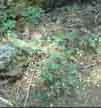



| Description | Distribution | Discussion | Horticultural Notes | Nomenclature | Links |

| Most common in central & southern Sierra Nevada, more scattered in northern Sierra Nevada and southern Cascade Mountains, north to Jackson Co., Oregon. Additional distributional representations available from links at entry for this species in the Jepson Interchange for On-Line Floristics |
The Sierra ground rose is most common in the understory of the lower montane forest, including the famous Sequoiadendron groves, where it forms open stands on the forest floor. The species is most distinctive at the southern end of its range, where the leaflets are widely and diagnostically blunt-tipped. Identity becomes problematic in the northern part of the range, where plants can be difficult to distinguish from non-fruiting Rosa gymnocarpa. However, the leaves of Rosa bridgesii are generally more or less finely hairy, whereas those of Rosa gymnocarpa are glabrous. One of the many synonyms of the Sierra ground rose, and in fact the earliest one published, is Rosa gymnocarpa var. pubescens S. Watson. In and around Yuba County, however, some populations (including the type of R. lesterae Eastwood) that are typical R. bridgesii in most other regards have leaflets that lack hairs, being instead dotted with glands.
In contrast to the understory habit of R. bridgesii in the central and southern Sierra Nevada, where the species is more common, at least some populations from the northern Sierra Nevada and Cascades Mountains of northern California and south Oregon occur on bare rocky ridges (see photos below). Oregon populations have been given the name R. spithamea var. solitaria L.F. Henderson, but thus far no significant morphological differences have been discerned between these plants and those from further south. The type of R. yainacensis might also represent this northern condition, though habitat is not recorded and extant populations from the type locality have not yet been found (see Nomenclature, below).

| plants growing on open rocky ridge, Huckleberry Mountain, Jackson Co., Oregon | 
| note solitary flowers, paired prickles, glabrous hips |
Probable Synonyms (working list):
R. bridgesii Crépin ex Rydb., North Amer. Fl. 22: 532. 1917 [not validly published by Crépin, Bull. Soc. Bot. Belg. 15: 54. 1876]: Bridges 62 -- California (K, B)
R. calvaria Greene, Leafl. Bot. Observ. Crit. 2: 257. 1912: Greene s.n., Jun 1889 -- Calaveras Big Trees, Calaveras Co., CA (HT: NDG11192!)
R. crenulata Greene, Leafl. Bot. Observ. Crit. 2: 255. 1912: Hall & Chandler 171-- Pine Ridge, Fresno Co., CA (HT: US!; IS: MO! NY! UC!)
R. dudleyi Rydb., Bull. Torrey Bot. Club 44: 73. 1917: Dudley 3388-- Converse Basin, Fresno Co., CA (HT: DS!)
R. gymnocarpa var. pubescens S. Watson in W.H. Brewer & Watson, Bot. Calif. 1: 187. 1876: Gray-- Wawona, CA (HT: GH)
R. lesterae Eastwood, Leafl. W. Bot. 3: 262. 1943: Rowntree s.n.-- between Dobbins and Camptonville, Yuba Co., CA (HT: CAS 290633!) = bridgesii with glabrous leaflets
R. spithamea var. solitaria L.F.Hend., Rhodora 33: 204. 1931: Henderson 13238-- Diamond Lake to North Umpqua River, Douglas Co., OR (HT: ORE)
R. spithamea var. subinermis Engelm., Bot. Gaz. 6: 236. 1881: Engelmann s.n.-- Fresno Big Trees, CA (HT: MO1798985!)
!R. yainacensis Greene, Pittonia 5: 109. 1903: Austin s.n.-- Yainax Indian Reservation, s OR (HT: NDG; fragment at NY!)